tire size MERCEDES-BENZ SPRINTER 2019 MY19 with no MMS Operator’s Manual
[x] Cancel search | Manufacturer: MERCEDES-BENZ, Model Year: 2019, Model line: SPRINTER, Model: MERCEDES-BENZ SPRINTER 2019Pages: 322, PDF Size: 5.91 MB
Page 131 of 322
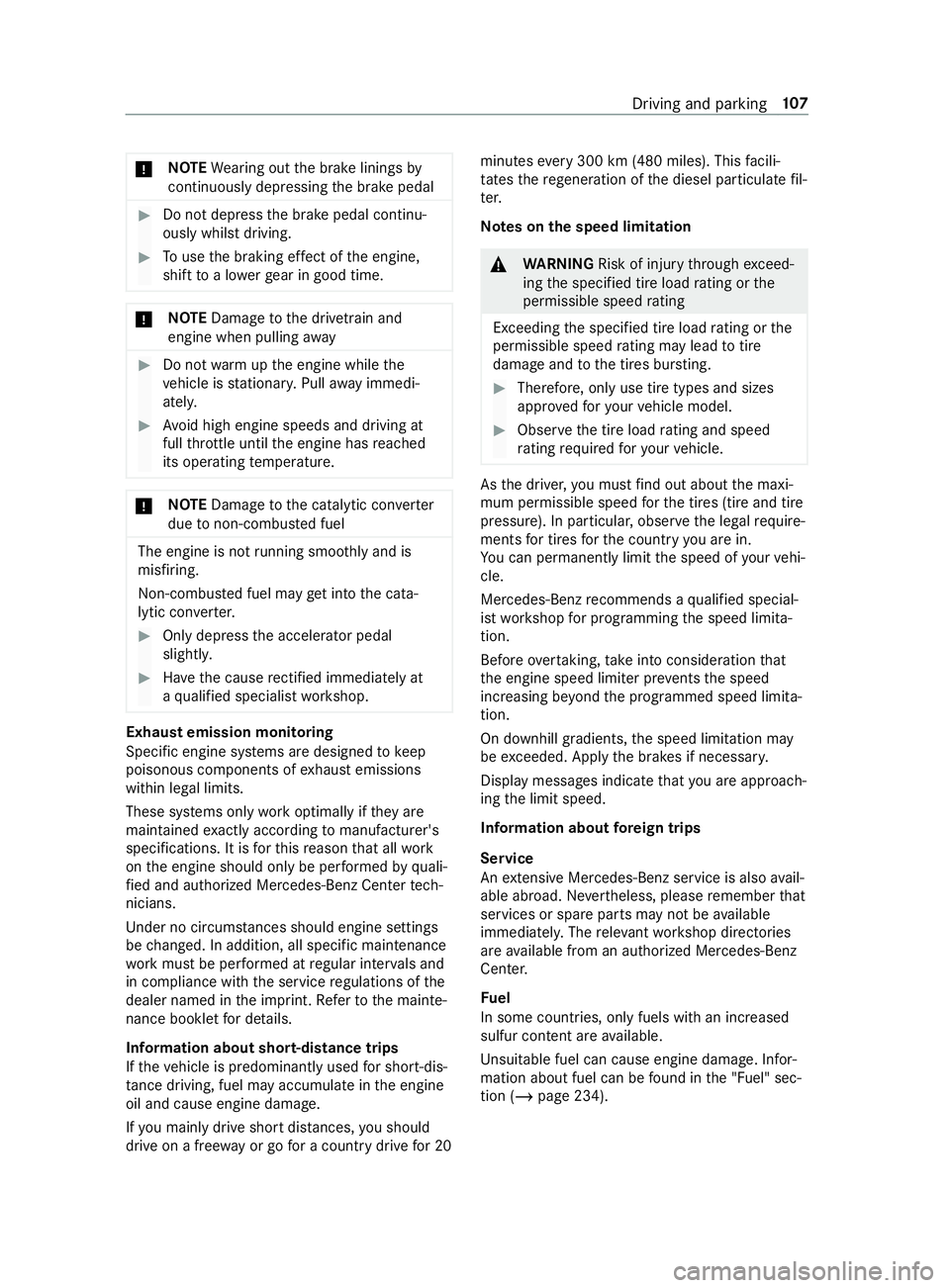
*
NO
TEWearing out theb rake linings by
continuously dep ressing theb rake pedal #
Do no tdepress theb rake pedal continu‐
ously whils tdriving. #
Touse theb raking ef fect of thee ngine,
shif ttoa lowe rgear in good time. *
NO
TEDama getothed rive trai nand
engin ewhen pulling away #
Do no twarmupt he engine while the
ve hicle is stationar y.Pull away immedi‐
atel y. #
Avoid high engine speeds and driving at
full thro ttle unti lthe engine has reached
its operatin gtemperature. *
NO
TEDama getothec atalytic con verter
due tonon-combu sted fuel The engine is no
trunnin gsmo othly and is
misfiring.
Non-combus tedf uel ma ygetintot he cata‐
lytic con verter. #
Onlydepress thea ccelera torp edal
slightly. #
Have thec ause rectified immedia tely at
aq ualifie dspecialis tworks hop. Exhaus
temission monitoring
Specific engine sy stems ar edesigned tokeep
poisonous components of exhaus temissions
within legal limits.
These sy stems onl yworko ptimally if they are
main tained exactly according tomanufacturer's
specifications. It is fort his reason that all work
on thee ngine should onl ybeperform ed byquali‐
fi ed and authorized Mercedes-Benz Center tech‐
nicians.
Under no circum stances shoul dengine settings
be changed. In addition ,all specific main tenance
wo rkmus tbep erform ed at regular inter vals and
in complianc ewitht he service regulations of the
dealer named in thei mp rint. Refe rtot he mainte‐
nance bookle tfor de tails.
Information about short-distance trips
If th ev ehicle is predominantl yused fors hort-dis‐
ta nce driving, fue lmayaccumulat einthe engine
oil and cause engine damage.
If yo um ainlydriv eshor tdista nces, yous hould
driv eonaf reew ay or go forac ountr ydrive for20 minutes
every300 km (480 miles). This facili‐
ta test he rege neration of thed iesel particulat efil‐
te r.
Note sont he speed limitation &
WARNING Risk of inju rythro ugh exceed‐
ing thes pecified tir eload rating or the
permissible speed rating
Exceeding thes pecified tir eload rating or the
permissible speed rating ma ylea dtot ire
dama geand tothet ires bur sting. #
Therefore, onl yuse tir etypes and sizes
appr ovedfor your vehicle model. #
Obser vethet irel oad rating and speed
ra ting requ ired fory our vehicle. As
thed rive r,yo um ustfind out about them axi‐
mum permissible speed fort he tires (tir eand tire
pressure). In particular ,obser vethel egal requ ire‐
ments fort ires fort he countr yyou ar ein.
Yo uc an permanently limit thes peed of your vehi‐
cle.
Mercedes-Benzr ecommendsaqualified special‐
is tw orks hop forp rogramming thes peed limita‐
tion.
Befor eovertaking, take intoc onsideration that
th ee ngine speed limiter pr events thes peed
increasing be yond thep rogrammed speed limita‐
tion.
On downhill gradients, thes peed limitation may
be exc eeded. Appl ythe brakes if necessar y.
Displ aymessages indica tethat youa reapproach‐
ing thel imit speed.
Information about fore ign trips
Service
An extensiv eMercedes-Benz service is also avail‐
able abroad. Ne vertheless, please remember that
services or spar eparts ma ynotbe available
immediatel y.The releva nt wo rkshop directories
ar ea vailable from an authorize dMercedes-Benz
Center.
Fu el
In some countries, onl yfuels wit hanincreased
sulfur con tent ar eavailable.
Uns uitable fuel can caus eengine damage. In for‐
mation abou tfuel can be found in the" Fuel" sec‐
tion (/ page234). Driving and parking
107
Page 162 of 322
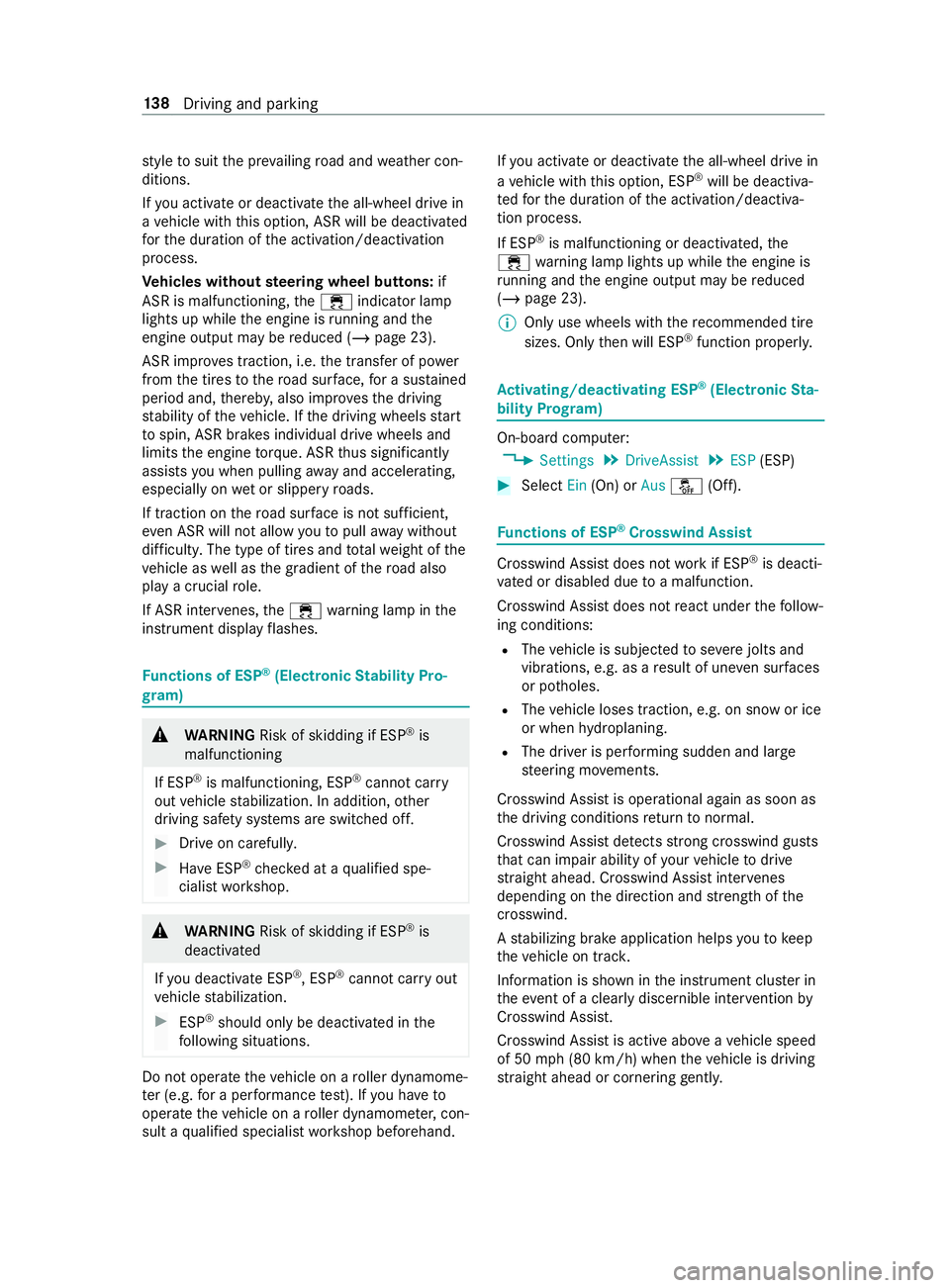
st
yletos uitthep reva iling road and weather con‐
ditions.
If yo ua ctivat eord eactivat ethe all-wheel driv ein
av ehicle wit hthis option, ASR will be deactivated
fo rt he duration of thea ctivation/deactivation
process.
Ve hicles without steering wheel but tons: if
ASR is malfunctioning, the00E5 indicator lamp
lights up while thee ngine is running and the
engine output ma ybereduced (/ page23).
ASR impr ovestraction, i.e. thet ransfer of po wer
from thet ires tother oad sur face, foras ustained
period and, thereb y,also impr ovesthe driving
st abilit yoft hevehicle. If thed riving wheels start
to spin, ASR brakes individuald rive wheels and
limits thee ngine torque. ASRthus significantly
assists youw hen pullin gawaya nd accelerating,
especiall yonw etor slippe ryroads.
If traction on ther oad sur face is no tsufficient,
eve nASR will no tallow youtop ullaway without
dif ficulty .The typ eoftires and totalwe ight of the
ve hicle as well as theg radient of ther oad also
pla yac rucial role.
If AS Rinter venes, the00E5 warning lam pinthe
instrument display flashes. Fu
nctions of ESP ®
(Electronic Stability Pro‐
gr am) &
WARNING Risk of skidding if ESP ®
is
malfunctioning
If ESP ®
is malfunctioning ,ESP ®
canno tcarry
out vehicle stabilization. In addition ,other
driving saf etys ystems ar eswitched off. #
Driv eonc arefull y. #
Have ESP ®
ch eckedataq ualified spe‐
cialis tworks hop. &
WARNING Risk of skidding if ESP ®
is
deactivated
If yo ud eactivat eESP®
,E SP ®
canno tcarry out
ve hicle stabilization. #
ESP ®
shoul donlybed eactivated in the
fo llowing situations. Do no
topera tethev ehicle on aroller dynamo me‐
te r( e.g. forap erform anc etest). If youh ave to
operat ethe vehicle on aroller dynamo meter,con‐
sult aqualified specialis tworks hop beforehand. If
yo ua ctivat eord eactivat ethe all-wheel driv ein
av ehicle wit hthis option, ESP ®
will be deactiva‐
te df or thed uration of thea ctivation/deactiva‐
tion process.
If ESP ®
is malfunctioning or deactivated, the
00E5 warning lam plight supw hilethee ngine is
ru nning and thee ngine output ma ybereduced
(/ page23).
% Onl
yuse wheels wit hthe recommended tire
sizes. Only then will ESP ®
function properly. Ac
tivating/deactivatin gESP®
(Electronic Sta‐
bility Prog ram) On-boa
rdcompu ter:
4 Settings 5
DriveAssist 5
ESP (ESP) #
Select Ein(On) or Aus00BB (Off). Fu
nctions of ESP ®
Crosswind Assist Crosswind Assis
tdoes no tworkifE SP®
is deacti‐
va tedord isabled due toam alfunction.
Crosswind Assis tdoes no treact under thef ollow‐
ing conditions:
R The vehicle is subjected tosevere jolts and
vib rations, e.g .asar esult of une vens urfaces
or po tholes.
R The vehicle loses traction, e.g. on sno worice
or when hydroplaning.
R The driver is per form ing sudden and lar ge
st eering mo vements.
Crosswind Assis tisoperational again as soon as
th ed riving conditions retur nton ormal.
Crosswind Assi stdetects stro ng crosswind gu sts
th at can impair abilit yofyourvehicle todrive
st ra ight ahead. Crosswin dAssis tinter venes
depending on thed irection and stre ngt hoft he
crosswind.
As tabilizing brak eapplicatio nhelps youtok eep
th ev ehicle on trac k.
Information is shown in thei nstrument clus terin
th ee vent of aclearly discernible inter vention by
Crosswind Assist.
Crosswind Assis tisactiveabove avehicle speed
of 50 mph(80 km/h )whent he vehicle is driving
st ra ight ahead or cornering gently. 13 8
Driving and pa rking
Page 205 of 322

#
Place asuitable collector beneat hdrain hose
2. #
Switc hont he ignition. #
Open drain scr ew1 until thew ater/fuel
mixtur eemerges from drain hose 2.#
Close drain scr ew1 as soon as around
0. 2qt( 0.2l iter) of thew ater/fuel mixtur ehas
been collected.
Af ter30s econds, thee lectrical fuel pump
automaticall ystops thed ischarg eofthe
wate r/fuel mixture. #
Afterd raining, switc hoffthei gnition. #
Dispose of thec ollected water/fuel mixture
in an environmentally responsible manner,
e.g. at aqualified specialis tworks hop. #
Chec kthat drain scr ew1 has been closed.
If th ee ngine is running whil edrain scr ew 1
is open, youw ill lose fuel thro ugh drain hose
2. #
Close theh ood (/ page173). #
003A The indicator lam pdoesn otgo out
af te rd raining: drainthe fuel filter again. #
003ATh eindica torlam pd oesn otgo out
af te rt he second draining: consultaquali‐
fi ed specialis tworks hop.
Mercedes-Benz recommends that youh avet he
fuel filter drained at aqualified specialis twork‐
shop. Cleaning and care
Note
sonw ashingthe vehicl einana utomatic
car wash &
WARNING Risk of accident du eto
re duced braking ef fect af terw ashing the
ve hicle
The braking ef fect is reduced af terw ashing
th ev ehicle. #
Aftert he vehicle has been washed,
brak ecarefully while paying attention to
th et raffic condition suntil theb raking
ef fect has bee nfully restored. *
NO
TERisk of damag etothe paintwork
and plastic components If
yo uw ash your vehicle in Touchles sAuto‐
matic Car Wash sy stems that use special
cleaning agents, thec leaning agentsu sed can damag
ethe paintwor korplastic components
of thev ehicle. #
Do no twash thev ehicle in Touchless
Au tomatic Car Wash sy stems that use
special cleaning agents. Mak
esuret hat thea utomatic car wash is suitable
fo rt he size of thev ehicle.
Befor ewashing thev ehicle in an automatic car
wa sh, fold in theo utside mir rors and remo veany
additional antennas. Otherwise, theo utside mir‐
ro rs,a ntennas or thev ehicle itself could be dam‐
aged.
Mak esurea nyadditional antennas ar ere-in stal‐
led and that theo utside mir rors aref ullyf olded
out again when youl eave thea utomatic car
wa sh.
To avo id damag etoyourvehicle, obser vethef ol‐
lowing befor eusing an automatic car wash:
R thes ide windo wsand thes liding windo ware
comple tely closed.
R theb lowe rfor ventilation and heating is
switched off.
R thew indshield wiper switc hisinposition005A.
If th ev ehicle is very dirty ,wash of fexcess dirt
befor ecleaning thev ehicle in an automatic car
wa sh.
% Re
moving thew ax from thew indshield and
th ew iper rubber safter wa shing thev ehicle,
will help avoid smearing and reduce wiper
noise. Note
sonu se ofapowe rwasher &
WARNING Risk of accident whe nusing
high-pressu recleaning equipment wi th
ro und-spr aynozzles
The wate rjet from around-spra ynozzle (dirt
grinder) ma ycaus edamag etotires and sus‐
pension components that is no tvisible.
Component sdamaged in this wa ym ayfail
unexpec tedly. #
Do no tuse high-p ressur ecleaning
equipment wit hround-spra ynozzle sto
clea nyour vehicle. #
Damaged tires or suspension compo‐
nentsm ustber eplaced immediatel y. Ne
veru se ap owe rwashe rinthevehicle interior.
The pressurized watercreated bythep ower Maintenance and care
181
Page 229 of 322
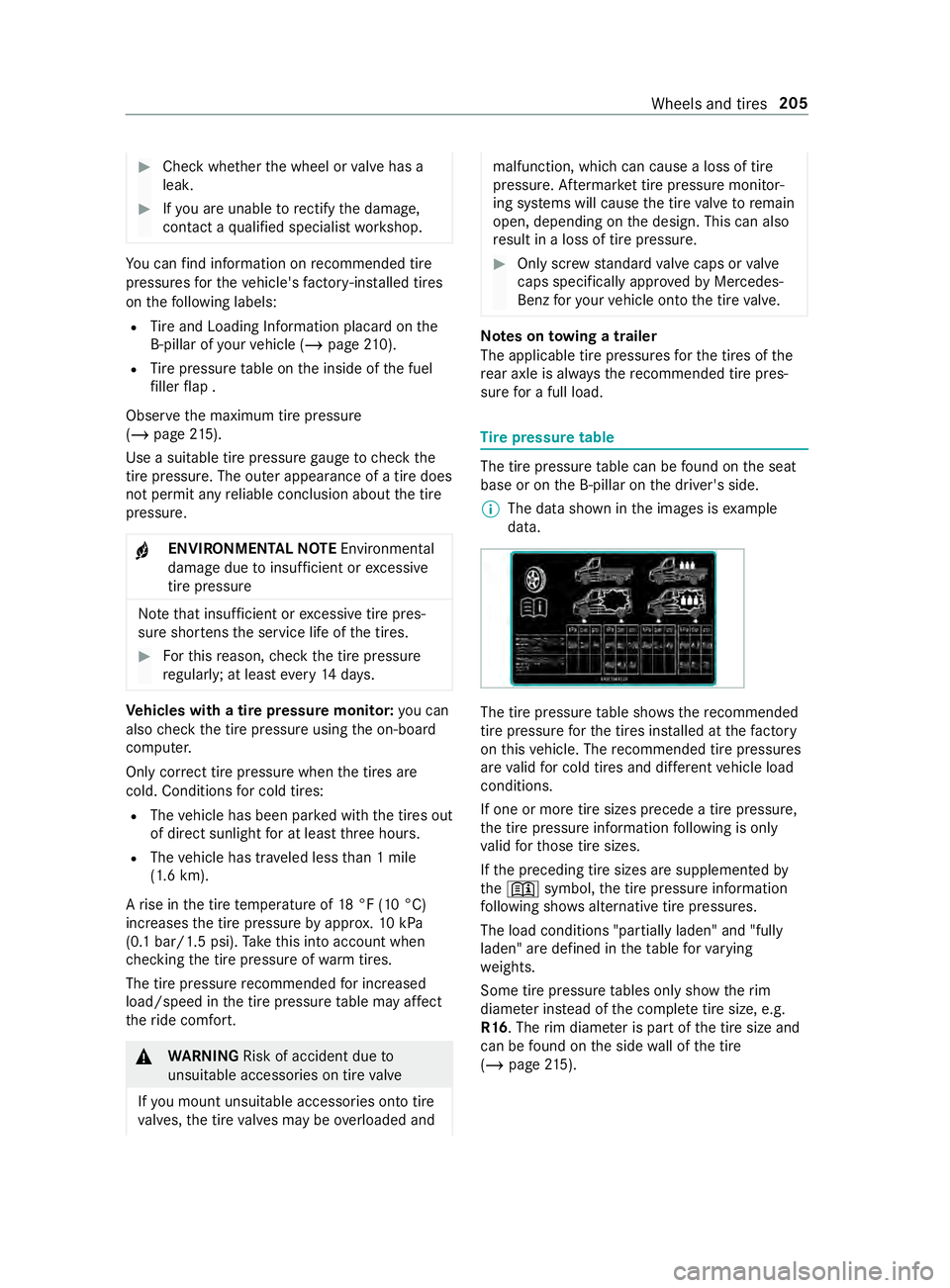
#
Chec kwhether thew heel or valveh as a
leak. #
Ifyo ua reunabl etorectify thed amage,
contact aqualified specialis tworks hop. Yo
uc an find information on recommended tire
pressures fort he vehicle's factor y-ins talled tires
on thef ollowing labels:
R Tire and Loadin gInforma tionp lacar dont he
B‑pi llarofyour vehicle (/ page210).
R Tire pressur etable on thei nside of thef uel
fi ller flap .
Obse rvet he maximum tir epressure
(/ page215).
Use asuita ble tir epressur egaug etoc heckthe
tir ep ressure. The ou tera ppearance of atired oes
no tp ermit an yreliable conclusion about thet ire
pressure.
+ ENVIRONMEN
TALN OTE Environmental
damag eduetoinsuf ficient or excessive
tir ep ressure No
tethat insuf ficient or excessiv etirep res‐
sur eshor tens thes ervice lif eofthe tires. #
Forthis reason ,chec kthe tir epressure
re gularly ;atleastevery 14 days. Ve
hicles with atirep ressur emonitor: youc an
also checkt he tir epressur eusing theo n-board
computer.
Onl ycorrect tir epressur ewhent he tires are
cold. Conditions forc old tires:
R The vehicle has been par kedw itht he tires out
of direct sunlight foratl east thre eh ours.
R The vehicle has tr aveled less than 1m ile
(1.6 km).
Ar ise in thet iret emperatur eof18°F( 10°C)
increases thet irep ressur ebya pprox.10k Pa
(0. 1b ar/1.5 psi). Take this int oaccount when
ch ecking thet irep ressur eofw armt ires.
The tir epressur erecommended fori ncreased
load/spee dinthe tir epressur etable ma yaffect
th er ide comfort. &
WARNING Risk of accident du eto
unsuitable accesso ries on tir evalve
If yo um ountunsuitable accesso ries ont otire
va lves, thet irev alves ma ybeoverloaded and malfunction
,whic hc an cause aloss of tire
pressure. Af term arke ttirep ressur emonitor‐
ing sy stems will cause thet irev alvetor emain
open ,depending on thed esign. This can also
re sult in aloss of tir epressure. #
Only scr ewstandar dvalvec aps or valve
cap sspecifically appr ovedbyM ercedes-
Benz fory our vehicle ont othe tir evalve. Note
sont owing atrailer
The applicable tir epressures fort he tires of the
re ar axle is alw ayst he recommended tir epres‐
sur efor afull load. Ti
re pressur etable The tir
epressur etable can be found on thes eat
base or on theB ‑pillar on thed rive r's side.
% The dat
ashown in thei mages is example
data. The tir
epressur etable sho ws therecommended
tir ep ressu refort he tires ins talled at thef actory
on this vehicle. The recommended tir epressures
ar ev alid forc old tires and dif fere nt vehicle load
conditions.
If one or mor etires izes precede atirep ressure,
th et irep ressur einformation following is only
va lid fort hose tir esizes.
If th ep receding tir esizes ar esupplemented by
the 0091 symbol, thet irep ressur einformation
fo llowing sho wsalternativ etirep ressures.
The load condition s"partiall yladen "and "fully
laden "aredefine dinthetable forv arying
we ights.
Som etirep ressur etables onl yshowt he rim
diame teri ns tead of thec omple tetires ize, e.g.
R16.T herimd iame terisp artoft he tir esize and
can be found on thes ide wall of thet ire
(/ page215). Wheels an
dtires 205
Page 232 of 322

Re
ar axle tir epressures on vehicles with rear wheel driv eand Super Single tires
Max. rear axle load 7055 lbs (3200 kg)Ti
re s/disc wheel Vehicl eload Max.rear axle load
7055 lbs (3200 kg)
225/75R16C 121/120R (122L) Fullyl aden
690 kPa(6.9b ar/100 psi) 3)
285/65R16C 131R Fully laden 460 kPa(4.6b ar/6 7psi) Max
.rear axl eload 7716 lbs (3500 kg) Ti
re s/disc wheel Vehicl eload Max.rear axle load
77 16 lbs (3500 kg)
225/75R16C 121/120R (122L) Fullyl aden
690 kPa(6.9b ar/100 psi) 3)
285/65R16C 131R Fully laden 520 kPa(5.2b ar/7 5psi) 3)
Va lid touse foras horttime as aspar ew heel
on ther ear axle foram aximu mdista nce of
62 miles (100 km) and amaximum speed of
34 mph(55 km/h).
Be sur etoalso obse rvet he following fur ther rela‐
te ds ubjects:
R Notesont irep ressur e(/pag e204)
R Tire and Loadin gInforma tionp lacard
(/ page210)
R Maximum tirep ressure (/ page 215) Ti
re pressur emonitor Fu
nction of tir epressur emonitor on single
tires &
DANG ER Risk of acciden tdue toincor‐
re ct tir epressure
Ever ytire, including thes par e(if pr ovided),
should be checkedw hen cold at leas toncea
mont hand inflated tothep ressur erecom‐
mended bythev ehicle manufacturer (see Tire
and Loadin gInforma tionp lacar dont he B-pil‐
lar on thed rive r’ss ide or thet irep ressure
label on thei nside of thef uel filler flap of your
ve hicle). If your vehicle has tires of adiffe re nt
size than thes ize indicated on theT irea nd
Loading In form atio nplacar dort he tirepres‐
sur etable, youn eedtod etermine thep roper
tir ep ressur efor those tires.
As an added saf etyf eature, your vehicle has
been equipped wit hatirep ressur emonitor‐ ing sy
stem (TPMS) that illuminates alow tire
pressur eindicator lam pwhen one or mor eof
yo ur tires ar esignificantl yunde rinfla ted.
Ac cordingly ,ifthe lo wtirep ressur eindicator
lam plights up, yous houl dstopa nd check
yo ur tires as soon as possible, and inflate
th em tothep roper pressure. Driving on asig‐
nificantly underinflated tir ecauses thet ireto
ove rheat and can lead totiref ailure. Underin‐
fl atio nalso inc reases fuel consum ption and
re duces tir etread life, and ma yaffect the
ve hicle's handling and braking ability .Please
no te that theT PMS is no tasubstitut efor
proper tir emaintenance, and it is thed rive r's
re sponsibility tomaintain cor rect tir epres‐
sure, even if underinflation has no treached
th el eve ltot rigger illumination of theT PMS
lo wt irep ressur eindicator lamp.
Yo ur vehicle has also been equipped wit ha
TPMS malfunction indicator toindicat ewhen
th es ystem is no toperating properly .The
TPMS malfunction indicator is combined with
th el ow tirep ressur eindicator lamp. When
th es ystem de tects am alfunction, thei ndica‐
to rlamp willf lashfora pproxima tely am inute
and then remain continuously illumina ted.
This sequence will continue upon subsequent
ve hicle start-ups as lon gasthe malfunction
ex ists.
When them alfunction indicator is illuminated,
th es ystem ma ynotbe able todetect or sig‐
nal lo wtirep ressu reas intended. TPMS mal‐
function smayoccur forav ariety of reasons,
includin gthe ins tallation of incompatible 208
Wheels and tires
Page 236 of 322
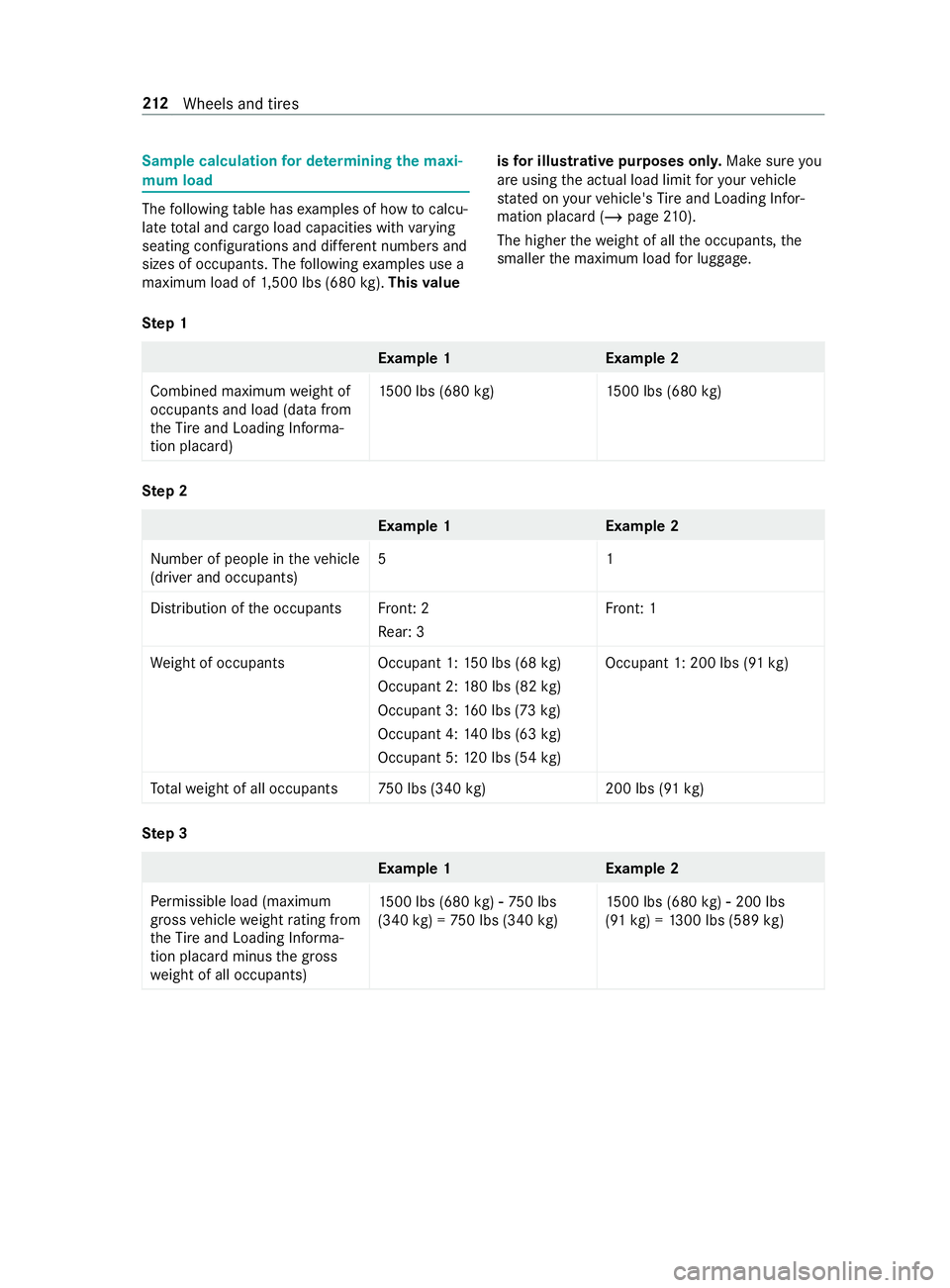
Sample calculation
ford eter mi ning them axi‐
mu mload The
following table has examples of ho wtocalcu‐
la te tota la nd cargo load capacities wit hvarying
seatin gconfigurations and dif fere nt number sand
size sofo ccupants. The following examples use a
maximum load of 1,500 lbs (680 kg).This value is
fori llustrativ epurposes on ly.Mak esurey ou
ar eu singthe actual load limit fory our vehicle
st ated on your vehicle's Tire and Loadin gInfor‐
mation pl acard( / pag e210).
Th eh igher thew eight of all theo ccupants, the
smaller them aximum load forl ug gage.
Ste p1 Example
1E xamp le 2
Combine dmaximum weight of
occupant sand load (dat afrom
th eT irea nd Loading In form a‐
tio np lacard) 15
00 lbs (680 kg)1 500 lbs (680kg) Ste
p2 Example
1E xamp le 2
Numb er of people in thev ehicle
(driver and occupants) 51
Distribution of theo ccupant sFront:2
Re ar:3 Fr
ont :1
We ight of occupant sO ccupant 1:150lbs (68 kg)
Occupant 2: 180lbs (82 kg)
Occupant 3: 160lbs (7 3kg)
Occupant 4: 140lbs (63 kg)
Occupant 5: 120lbs (5 4kg) Occupant 1: 200 lbs (9
1kg)
To talw eight of all occupant s750 lbs (340 kg)2 00 lbs (91kg) Ste
p3 Example
1E xamp le 2
Pe rm issible load (maximum
gross vehicle weight rating from
th eT irea nd Loading In form a‐
tio np lacar dminus theg ross
we ight of all occupants) 15
00 lbs (680 kg)00F875 0lbs
(340 kg)=7 50 lbs (340 kg)15
00 lbs (680 kg)00F8200 lbs
(9 1k g)=1 300 lbs (589 kg) 212
Wheels and tires
Page 237 of 322

Ti
re labeling Overvie
woftirel abeling 1
Uniform Ti reQuality Grading Standards
(/ page213 )
2 DOT(Depa rtment of Transpor tation), (TIN)
Ti re Identification Number (/ page214 )
3 Maximum tirel oa d( /pa ge214)
4 Maximum tirep ressur e(/ page 215)
5 Manufac turer
6 Characteristics of thet ire( /pag e215 )
7 Tire size designation, load-beari ng capacity,
speed rating and load ind ex (/pag e215 )
8 Tire name
% The da
tashown in thei llustration is sample
data. Information on tir
equality grades Ac
cording tother equirements of theU .S.
Depa rtment of Transpor tation's "Uni form Tire
Quality Grading Standards" tir emanufacturers
mus tgrade their tires using thef ollowing three
per form anc efactors: 1
Tread weargrade
2 Traction grade
3 Temp eratur egrade
% The dat
ashown in thei llustration is sample
data.
% This grading is no
tlegall yprescribed forC an‐
ada,b ut specified in mos tcases anyw ay.
Tr ead weargrade
The tread wear grade is acomparativ egrading
based on tread wear grade testsc onducted
under contro lled condition sonaspecified U.S.
Depa rtment of Transpor tatio nt esttrack .F or
ex ample, atireg raded 150w ould wear one and
one-half times as well on theg ove rnment test
trac kasat ireg rade d1 00.
The relativ eperform anc eoft ires depends upon
th ea ctual conditions of their use, ho wever,and
ma ydepar tsignificantl yfromt he nor mdueto
va riations in drivin ghabits, servic epractices and
dif fere nces in road characteristic sand climate
conditions.
Tr actio ngrade &
DANG ER Risk of acciden tdue toinade‐
qu atet raction
The traction grade assigned tothis tir eis
based on stra ight-ahead brakin gtraction
te sts, and does no tinclude either accelera‐
tion, cornering, hydroplaning or peak traction
ch aracteristics. #
Alwaysa dap tyour driving stylea nd
driv eatas peedtosuit thep reva iling
traf fica nd weather conditions. *
NO
TEDama getothed rive trai nfrom
wheelspin #
Avoid wheelspin. The traction grades
–fromh ighes ttolowest –
ar eA A, A, Band C. These grades relat etot he Wheels and tires
213
Page 238 of 322
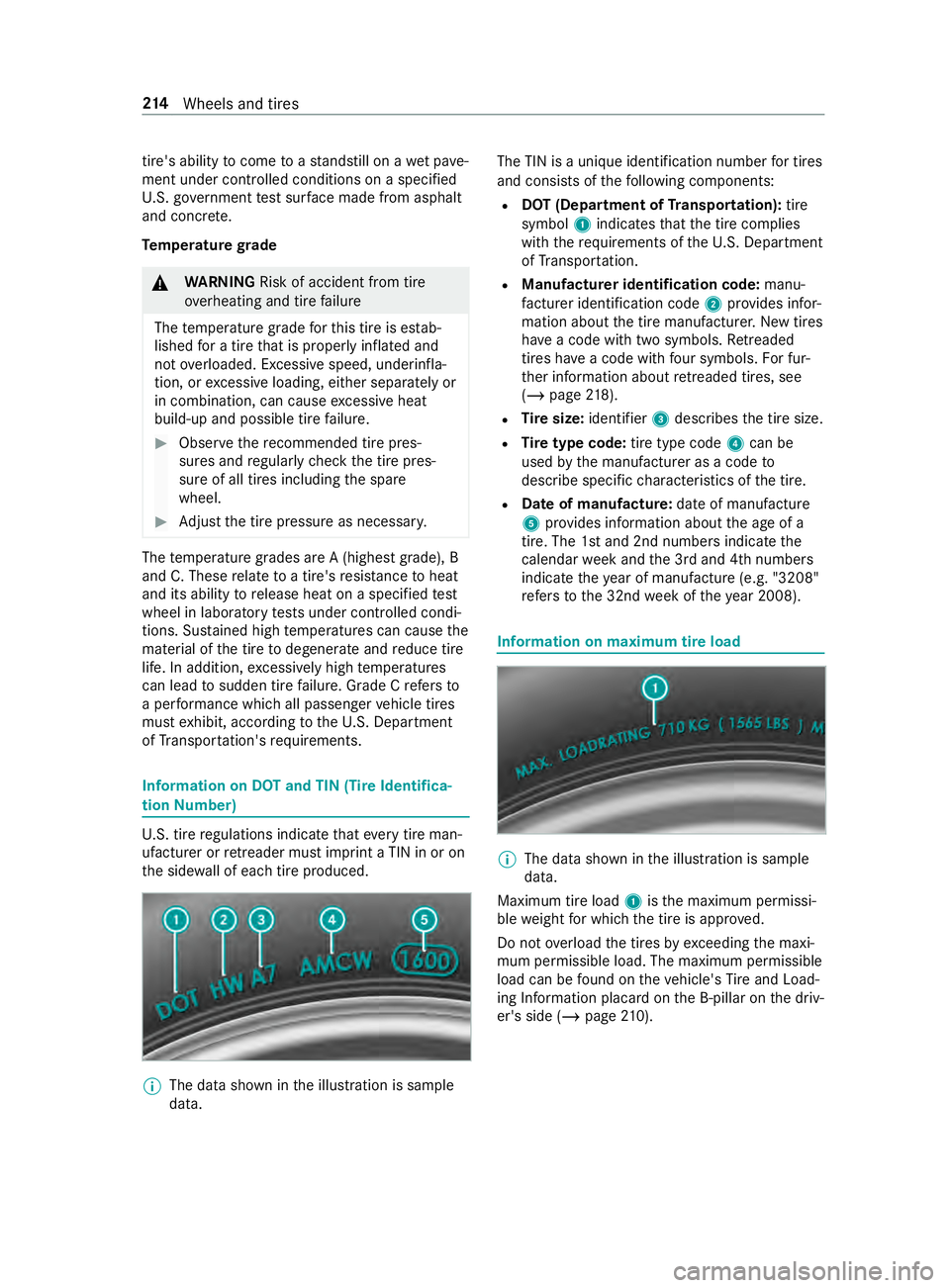
tire's ability
tocome toas tandstill on awetpave‐
ment under controlle dconditions on aspecified
U. S. go vernment test sur face mad efroma sphalt
and concr ete.
Te mp eratur egrade &
WARNING Risk of accident from tire
ove rheating and tir efailure
The temp eratur egrade fort his tir eisestab‐
lished forat iret hat is properly inflated and
no to verloaded. Excessiv espeed, underinfla‐
tion, or excessiv eloading, either separatel yor
in combination, can cause excessiv eheat
build-up and possible tir efailure. #
Obser vether ecommended tir epres‐
sures and regular lych eckt he tir epres‐
sur eofa ll tires including thes pare
wheel. #
Adjus tthe tir epressur easn ecessar y. The
temp eratur egrades ar eA(highes tgrade), B
and C. These relat etoat ire'sresis tance toheat
and its ability torelease heat on aspecified test
wheel in laborator ytests under cont rolled condi‐
tions. Sus tained high temp eratures can cause the
material of thet iretod egenerat eand reduce tire
life. In addition, excessivel yhigh temp eratures
can lead tosudden tir efailure. Grade Crefer sto
ap erform anc ewhicha ll passenger vehicle tires
mus texhibit, accordin gtotheU.S. Depa rtment
of Transpor tation's requ irements. Information on DO
Tand TIN (Tir eIdentifica‐
tion Number) U.
S. tir eregulations indicat ethat everyt irem an‐
ufacturer or retreade rmustimp rint aT IN in or on
th es ide wall of eac htirep roduced. %
The dat
ashown in thei llustration is sample
data. The TIN is
aunique identification number fort ires
and consists of thef ollowing components:
R DOT(Department of Transportation): tire
symbol 1indicates that thet irec omplies
wit hthe requ irements of theU .S. Depa rtment
of Transpor tation.
R Manufacturer identi fication code: manu‐
fa cturer identification code 2prov ides infor‐
matio nabout thet irem anufacturer .New tires
ha ve ac odew itht wo symbols. Retreaded
tires ha veac odew ithf our symbols.F or fur‐
th er information about retreade dtires, see
(/ page 218).
R Tire size: identifier 3describes thet ires ize.
R Tire type code: tiret ypec ode 4can be
used bythem anufacturer as acode to
describe specific characteristic softhe tire.
R Dat eofm anufactu re:date of manufacture
5 prov ides informatio nabout thea geof a
tire. The 1s tand 2nd number sindicat ethe
calendar week and the3 rdand 4t hnumbers
indicat ethe year of manufactur e(e.g. "3208"
re fers to the3 2ndw eek of they ear 2008). Information on maximum tir
eload %
The dat
ashown in thei llustration is sample
data.
Maximum tir eload 1isthem aximum permissi‐
ble weight forw hichthe tir eisa pprove d.
Do no toverload thet ires by ex ceeding them axi‐
mum permissible load. The maximum permissible
load can be found on thev ehicle's Tire and Load‐
ing In form atio nplacar dont he B-pillar on thed riv‐
er's side (/ page210). 214
Wheels and tires
Page 239 of 322

Information on maximum tir
epressu re %
The dat
ashown in thei llustration is sample
data.
Maximum permitted tir epressure 1,whichis
permitted fort he tires mus tnotbe exceeded.
Exception: whe nusing the2 25/ 75R16C
12 1/120R (122L) tires as aspare wheel on the
re ar axle of Supe rSinglev ehicles wit hadista nce
limit of 62 mi (100 km) and speed limit of 34 mph
(55 km/h). Information on tir
echaracteristics %
The dat
ashown in thei llustration is sample
data.
This information describes thet ype of tir ecord
and then umber of la yers in side wall1 and
under tir etread 2. Ti
re size designation, load-bearing capacity,
speed ratin ga nd load index &
WARNING Risk of inju rythro ugh exceed‐
ing thes pecified tir eload rating or the
permissible speed rating
Exceeding thes pecified tir eload rating or the
permissible speed rating ma ylea dtot ire
dama geand tothet ires bur sting. #
Therefore, onl yuse tir etypes and sizes
appr ovedfor your vehicle model. #
Obser vethet irel oad rating and speed
ra ting requ ired fory our vehicle. 1
Prefixing letter
2 Nominal tir ewidthinm illimeters
3 Aspect ratio (i npercent)
4 Tire code
5 Rimd iame ter
6 Load-bearing index
7 Speed rating
8 Loadind ex
% The dat
ashown in thei llustration is sample
data.
Fu rther information about reading tir edatac an
be obtaine dfroma nyqualified specialis twork‐
shop.
Prefixing letter 1 1:
R "LT": light truc ktires in accordance wit hUS
manufacturer standards.
R "C": tires forc ommercial usage in accordance
wit hE uropean manufacturer standards.
Aspect ratio (i npercent) 3 3:
The size ratio betwee nthe tir eheight and tire
widt hand is shown in percent (tir eheight divided
by tirew idth ).
Ti re code 4 4(tiretype):
R "R": radial tire
Rim diam eter 5
5:
The diame teroft he bead seat (no tthe diame ter
of ther im flange). The rimd iame teriss pecified in
inches (in).
Load-bearing index 6 6:
Numerical code whic hspecifies them aximum
load-bearing capacity of atire( "91" equals, e.g.
13 56 lb (6 15kg)).
The tir eload-bearing capacit ymustbeatl east
half theg ross axle weight rating of thev ehicle. Wheels and tires
215
Page 241 of 322
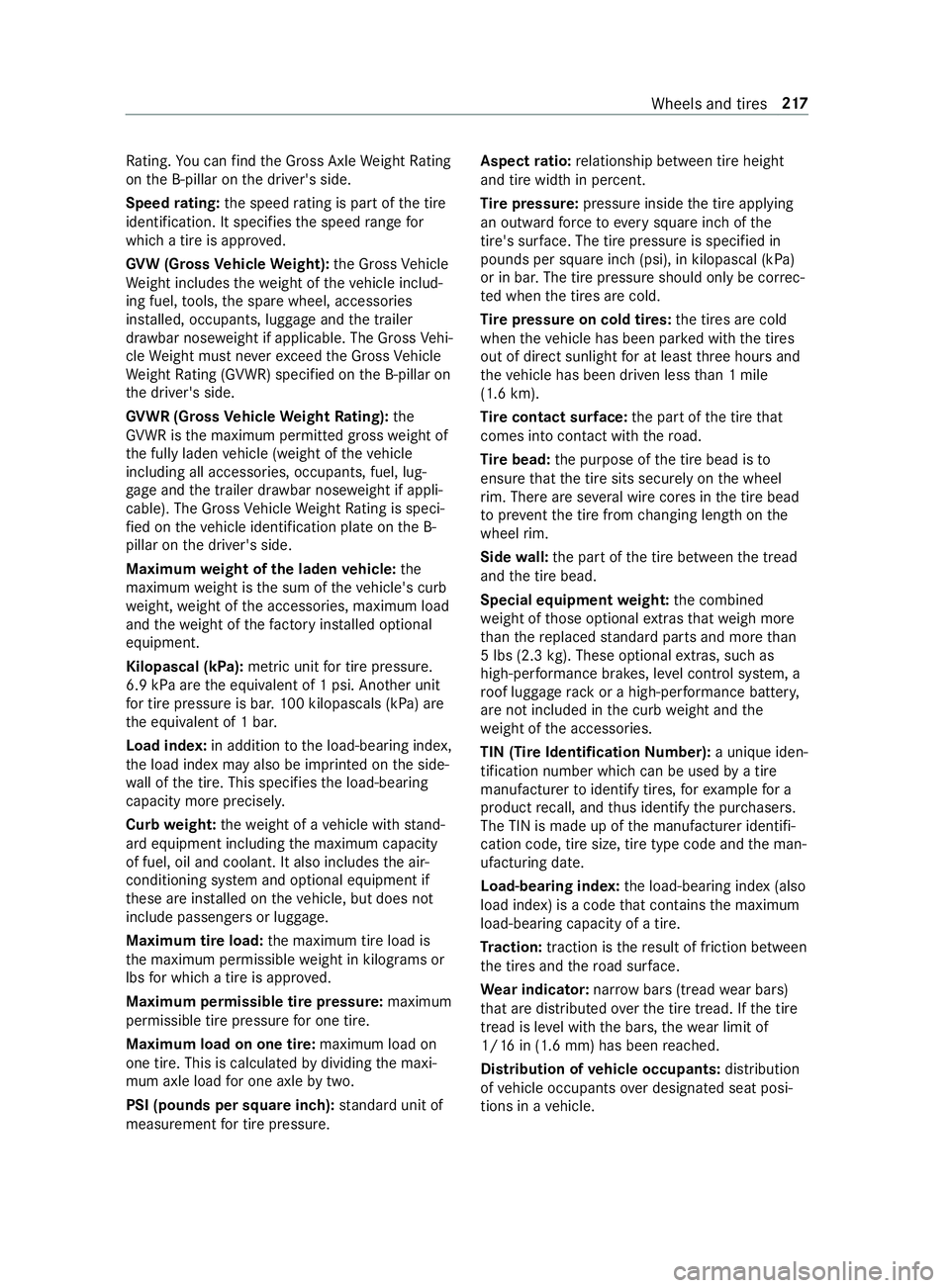
Ra
ting .You can find theG ross Axle Weight Rating
on theB -pillar on thed rive r's side.
Speed rating: thes peed rating is pa rtof thet ire
identification .Itspecifies thes peed rang ef or
whic hatireisa pprove d.
GV W( Gross Vehicl eW eight): theG ross Vehicle
We ight includes thew eight of thev ehicle includ‐
ing fuel, tools, thes par ew heel, accessories
ins talled, occupants, luggag eand thet railer
dr aw bar nose weight if applicable. The Gross Vehi‐
cle Weight mus tnever exceed theG ross Vehicle
We ight Rating (GVWR )specifie donthe B-pillar on
th ed rive r's side.
GV WR (Gross Vehicl eW eight Rating): the
GV WR is them aximum permitted gross weight of
th ef ully laden vehicle (weight of thev ehicle
including all accessories, occupants, fuel, lug‐
ga ge and thet railer dr awbar nose weight if appli‐
cable). The Gross Vehicle Weight Rating is speci‐
fi ed on thev ehicle identification plat eonthe B-
pillar on thed rive r's side.
Maximum weight of thel aden vehicle: the
maximu mweight is thes um of thev ehicle's curb
we ight ,weight of thea ccessories, maximum load
and thew eight of thef actor yins talled optional
equipment.
Kilopascal (kPa): metric unitfort irep ressu re.
6.9 kP aarethee quivalent of 1psi. Ano ther unit
fo rt irep ressu reis bar .100 kilopascals (kPa) are
th ee quivalent of 1bar.
Load index: in additiontothel oad-bearing index,
th el oad inde xmayalso be imprinted on thes ide‐
wa ll of thet ire. This specifies thel oad-bearing
capacity mor eprecisel y.
Cur bw eight: thew eight of avehicle wit hstand‐
ar de quipmen tincludin gthe maximum capacity
of fuel, oil and coolant. It also includes thea ir-
conditioning sy stem and optional equipment if
th ese ar einstalled on thev ehicle, but does not
include passenger sorluggage.
Maximum tir eload: them aximum tir eload is
th em aximum permissible weight in kilog rams or
lbs forw hichat ireisa pprove d.
Maximum permissible tir epressure: maximum
permissible tir epressur efor one tire.
Maximum load on one tire: maximum load on
one tire. This is calculated bydividing them axi‐
mum axle load foro ne axle bytwo.
PSI (pounds per squar einch): standar dunit of
measuremen tfor tir epressu re. Aspec
tratio: relationship between tir eheight
and tir ewidthinp ercent.
Ti re pressure: pressureinside thet irea pplying
an outwar dforce toeve rysquar einc hoft he
tire's sur face. The tir epressur eiss pecified in
pounds per squar einc h( psi), in kilopascal (kPa)
or in bar .The tir epressur eshould onl ybecorrec‐
te dw hen thet ires ar ecold.
Ti re pressur eoncoldt ires: thet ires ar ecold
when thev ehicle has been par kedw itht he tires
out of direct sunlight foratl east thre eh our sand
th ev ehicle has been driven less than 1m ile
(1.6 km).
Ti re contact sur face: thep artoft he tir ethat
comes int ocontact wi th theroad.
Ti re bead: thep urpose of thet ireb ead is to
ensur ethat thet ires its securely on thew heel
ri m. Ther eareseveralw irec ores in thet ireb ead
to preve ntthet iref romc hanging lengt honthe
whee lrim.
Sid ew all: thep artoft he tir ebetwe en thet read
and thet ireb ead.
Special equipment weight: thec ombined
we ight of those optional extras that we igh more
th an ther eplaced standar dparts and mor ethan
5l bs (2. 3kg). These optiona lextras ,suc has
high-pe rformance brakes, le velc ontrol sy stem, a
ro of luggag erackorah igh-perform anc ebatter y,
ar en otincluded in thec urb weight and the
we ight of thea ccessories.
TIN (Tir eIdentification Number): auniqu eiden‐
tification number whic hcan be used byatire
manufacturer toidentify tires, fore xamp lefora
product recall, and thus identif ythe pur chasers.
The TIN is made up of them anufacturer identifi‐
cation code, tir esize, tir etype code and them an‐
ufacturing date.
Load-bearing index: thel oad-bearing inde x(also
load index) is acode that con tains them aximum
load-bearing capacity of atire.
Tr action: traction is ther esult of friction between
th et ires and ther oad sur face.
We ar indicator: narrow bars(tread wear bars)
th at ar edistributed overthe tir etread. If thet ire
tread is le velw itht he bars, thew ear limit of
1/1 6in( 1.6m m) has been reached.
Distribution of vehicl eoccupants: distribution
of vehicle occupants over designated seat posi‐
tions in avehicle. Wheels and tires
217